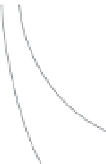Geoscience Reference
In-Depth Information
capacitive reactance and is a form of impedance. It results
in a phase difference between the voltage applied to the
capacitor and the current
flowing into it; the current leads
the variation in voltage (
Fig. 5.5b
), opposite to that caused
by inductive reactance (see
Section 5.2.2.2
)
. The lead in
current varies between 0° and 90° (being greatest when the
resistance of the external circuit is least).
The above description suggests the possibility of
measuring the capacitance of a circuit in three ways:
firstly, by monitoring current flow after a direct current
is discontinued; secondly, by comparing the resistance of
the circuit at different frequencies of alternating current;
and thirdly, by measuring the phase difference between
an alternating voltage and its associated current flow.
Capacitance effects are fundamental in determining
the induced polarisation responses of rocks and min-
erals, as described in
Section 5.3.2
,
andalthree
methods are used in geophysical surveying to measure
it (see
Section 5.6.3
)
.
a)
Magnetic field lines
Wire
Current
flow
b)
Current
flow
Magnetic field direction
in the centre of the loop
c)
5.2.2
Fundamentals of electromagnetism
Current
flow
When electrical charges move, i.e. when an electric cur-
rent is
flowing, a magnetic
eldisformedaroundthem
and the intensity (strength) of the
field is proportional to
the magnitude of the current. For current
flowing
through a straight length of wire, the magnetic
field is
described by circular
field lines concentric to the current
(
Fig. 5.7a
). The direction of the magnetic field is depend-
ent on the direction of current flow and described by the
'
Magnetic field direction
in the centre of the loop
Figure 5.7
Magnetic
flowing
through a straight segment of wire, and described by the right-hand
rule where the thumb points in the direction of current
field of an electric current. (a) Current
ow and the
curled
fingers point in the direction of the circular magnetic
field
lines; (b)
flowing through a circular loop of wire. (c) The magnetic
dipole
field of an isolated current-carrying loop.
rule (
Fig. 5.7a
). The strength of the field
decreases with increasing distance from the current flow
(the wire).
When a current-carrying wire is formed into a single
and in the plane of the loop, where the
right-hand
'
right hand so the fingers point in the direction of current
flow through the coil, the thumb points to the north
pole. The field of an infinitely small bar magnet
approaches that produced by a single circular current
carrying coils and loops of wire is an integral part of the
EM method.
field lines point
in the same direction and are parallel to the axis of the
loop. The direction of the current
flow determines the
direction of the magnetic
field. When a current-carrying
wire is formed into a series of electrically connected
loops it forms a coil. The magnetic
fields of each turn
ing the number of turns increases the length of the coil
and the strength of the
field, as does increasing the
coil is like that of a bar magnet (see
Section 3.2.3.1
). The
north pole of the magnetic field is again found using the
5.2.2.1
Inductance
Inductance is the tendency of a circuit to oppose any
change in the current
owing through it owing to the
effects of energy stored in the magnetic
fields associated
with the moving charges. Using the plumbing analogy, it is
analogous to the inertia of
the water that must be















































































































































































Search WWH ::

Custom Search